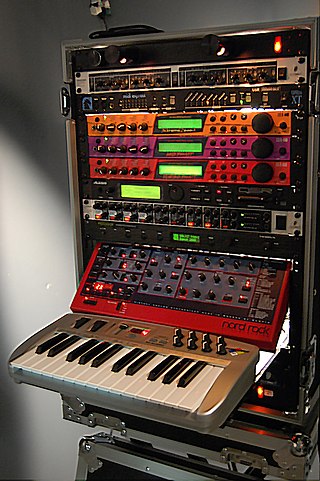
MIDI is a technical standard that describes a communication protocol, digital interface, and electrical connectors that connect a wide variety of electronic musical instruments, computers, and related audio devices for playing, editing, and recording music.
Finale is a discontinued proprietary music notation software developed and released by MakeMusic for Microsoft Windows and macOS from 1988 until 2024, when it was discontinued.

An electronic keyboard, portable keyboard, or digital keyboard is an electronic musical instrument based on keyboard instruments. Electronic keyboards include synthesizers, digital pianos, stage pianos, electronic organs and digital audio workstations. In technical terms, an electronic keyboard is a rompler-based synthesizer with a low-wattage power amplifier and small loudspeakers.

Pro Tools is a digital audio workstation (DAW) developed and released by Avid Technology for Microsoft Windows and macOS. It is used for music creation and production, sound for picture and, more generally, sound recording, editing, and mastering processes.

GarageBand is a software application by Apple for macOS, iPadOS, and iOS devices that allows users to create music or podcasts. It is a lighter, amateur-oriented offshoot of Logic Pro. GarageBand was originally released for macOS in 2004 and brought to iOS in 2011. The app's music and podcast creation system enables users to create multiple tracks with software synthesizer presets, pre-made and user-created loops, an array of various effects, and voice recordings.
A scorewriter, or music notation program is software for creating, editing and printing sheet music. A scorewriter is to music notation what a word processor is to text, in that they typically provide flexible editing and automatic layout, and produce high-quality printed results.

A digital audio workstation is an electronic device or application software used for recording, editing and producing audio files. DAWs come in a wide variety of configurations from a single software program on a laptop, to an integrated stand-alone unit, all the way to a highly complex configuration of numerous components controlled by a central computer. Regardless of configuration, modern DAWs have a central interface that allows the user to alter and mix multiple recordings and tracks into a final produced piece.

Renoise is a digital audio workstation (DAW) based upon the heritage and development of tracker software. Its primary use is the composition of music using sound samples, soft synths, and effects plug-ins. It is also able to interface with MIDI and OSC equipment. The main difference between Renoise and other music software is the characteristic vertical timeline sequencer used by tracking software.

SCORE is a scorewriter program, written in FORTRAN for MS-DOS by Stanford University Professor Leland Smith (1925–2013) with a reputation for producing very high-quality results. It was widely used in engraving during the 1980s and 1990s and continues to have a small, dedicated following of engravers, many of whom hold the program in high regard due to its ability to position symbols precisely on the page. Several publications set using SCORE have earned Paul Revere and German Musikpresse engraving awards.

Encore is a music notation (scorewriter) program for Microsoft Windows and macOS.

Ensoniq ESQ-1 is a 61-key, velocity sensitive, eight-note polyphonic and multitimbral synthesizer released by Ensoniq in 1985. It was marketed as a "digital wave synthesizer" but was an early Music Workstation. Although its voice generation is typically subtractive in much the same fashion as most analog synthesizers that preceded it, its oscillators are neither voltage nor "digitally controlled", but true digital oscillators, provided by a custom Ensoniq wavetable chip. The signal path includes analog resonant low-pass filters and an analog amplifier.

Denemo is a scorewriter and music sequencer. Denemo has been under development since 1999.

Logic Pro is a proprietary digital audio workstation (DAW) and MIDI sequencer software application for the macOS platform developed by Apple Inc. It was originally created in the early 1990s as Notator Logic, or Logic, by German software developer C-Lab which later went by Emagic. Apple acquired Emagic in 2002 and renamed Logic to Logic Pro. It was the second most popular DAW – after Ableton Live – according to a survey conducted in 2015.
Music Write is a Windows-based music notation program created by Voyetra Music Software. It uses a MIDI-based system for storing events, and the most recent versions save music in MWK files, similar to Standard MIDI Files with additional text and symbol events. Currently, Voyetra offers three editions of Music Write: Starter Kit, Songwriter edition, and Maestro edition. All support printing, MIDI recording, and MIDI playback granted the user has the appropriate hardware.

Passport Designs Inc. was a software company that created early music production software, such as the pre-MIDI SoundChaser in 1982. Other programs included Master Tracks Pro and Encore.

Mozart the music processor is a proprietary WYSIWYG scorewriter program for Microsoft Windows. It is used to create and edit Western musical notation to create and print sheet music, and to play it via MIDI.

Logic Studio is a discontinued professional music production suite by Apple Inc. The first version of Logic Studio was unveiled on September 12, 2007. It claims to be the largest collection of modeled instruments, sampler instruments, effect plug-ins, and audio loops ever put in a single application.

Disklavier is a brand of reproducing pianos manufactured by Yamaha Corporation. The first Disklavier was introduced in the United States in 1987.

Overture is a music notation (scorewriter) program for Windows and Macintosh platforms, published and developed by Sonic Scores. While Overture is primarily a scorewriter program, it also allows editing the score's MIDI audio playback data in the manner of sequencer and digital audio workstation (DAW) software.

Anvil Studio is a multitrack MIDI and audio editing, digital audio workstation program that runs on Microsoft Windows. It is developed by Willow Software, based in Shoreline, Washington, U.S.A.
















